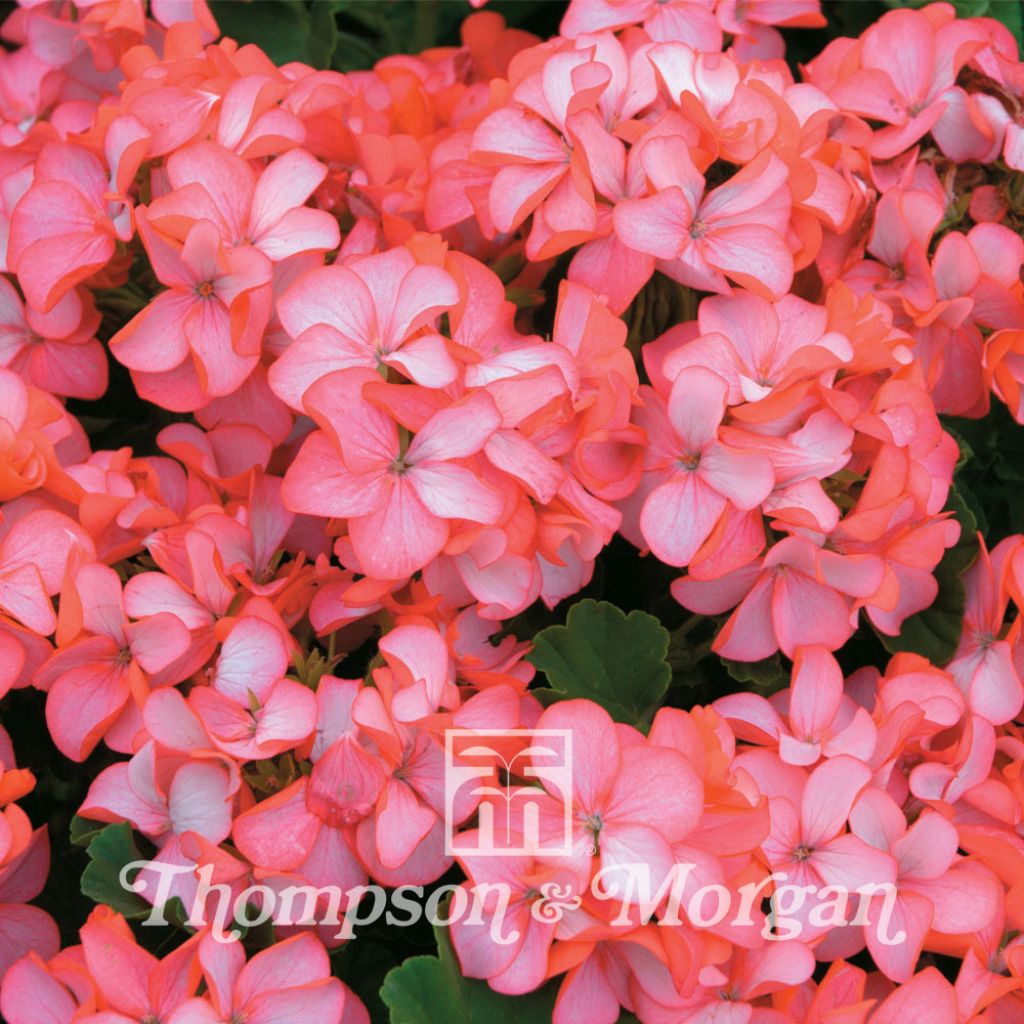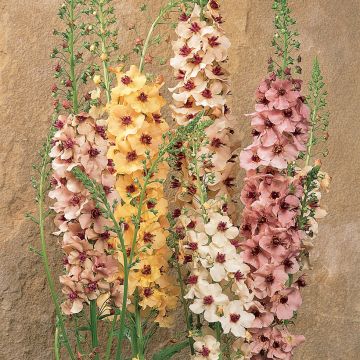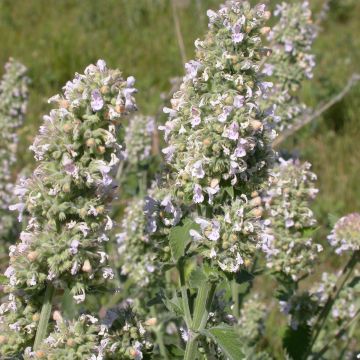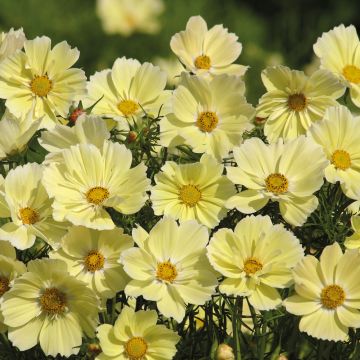

Geranium Horizon Pink Ice F1 Hybrid
Pelargonium Horizon Pink Ice - F1 Hybrid seed
Pelargonium x hybrida Horizon Pink Ice F1 Hybrid
Geranium, Garden Geranium, Zonal Geranium
This plant carries a 6 months recovery warranty
More information
We guarantee the quality of our plants for a full growing cycle, and will replace at our expense any plant that fails to recover under normal climatic and planting conditions.
Seed-only orders are dispatched by sealed envelope. The delivery charge for seed-only orders is €3.90.
Delivery to Corse prohibited: UE law prohibits the import of this plant from mainland France to Corse as part of the fight against Xylella fastidiosa. Please accept our sincere apologies.
More information
Does this plant fit my garden?
Set up your Plantfit profile →
Description
pelagonium Horizon Pink Ice F1 Hybrid is a bushy and compact, compound zonal pelargonium. This variety is robust and has sturdy stems that bear bright pink flowers with a beautiful round and bright green leaf. It blooms from early summer if sown from January to mid-March, forming small round bushes. Ideal for small gardens, hanging baskets, and planters.
Zonal pelargoniums are perennial hybrids of the geranium family, belonging to the larger group called Pelargonium x hortorum. Most of them are derived from Pelargonium inquinans, originating from the southeastern tip of Africa, with contributions from Pelargonium zonale and Pelargonium frutetorum. The Horizon Pink Ice F1 Hybrid geranium forms a bushy clump with a fairly compact habit and moderate development, reaching a minimum size of 32 cm (13in) in all directions. It blooms from spring to autumn with medium-sized pure pink flowers with wide petals which stand out nicely against the bright green foliage. Its sturdy and succulent stems bear circular, wavy leaves with toothed edges and a thick, healthy texture.
Once reserved for balconies and terraces, zonal pelargoniums are now making an entrance into sunny flower beds and borders. Plant them en masse to create a long-lasting and cheerful display throughout the summer. These plants tolerate drought quite well, allowing them to be paired with garden verbenas, stunning blue lobelias and black or purple-leaved Ipomoeas (Illusion, Midnight Lace, Ipomoea Sweet Heart Purple). Create beautiful pots and hanging baskets by combining them with white or red varieties, Million Bells, variegated periwinkles, Dichondra Silver Falls, violets, and calibrachoas.
Report an error about the product description
Flowering
Foliage
Plant habit
Botanical data
Pelargonium
x hybrida
Horizon Pink Ice F1 Hybrid
Geraniaceae
Geranium, Garden Geranium, Zonal Geranium
Cultivar or hybrid
Other Thompson and Morgan seeds
Planting and care
You can sow the seeds of pelargonium outdoors, where they are to flower in April-May, after the frosts. Choose a sunny location with well-drained, prepared and friable soil. Sow the seeds finely, to a depth of 3mm (0in), with a spacing of 30 cm (12in). Water regularly, especially during dry periods. Germination usually takes about twenty days. When the plants are large enough to handle, transplant them 15 cm (6in) apart.
Another alternative is to sow indoors from August to September to flower in early summer the following year. Sow the seeds on the surface of good quality compost at a temperature of 18-20°C (64.4-68°F), and cover with a pinch of very fine compost or vermiculite. Do not exclude light as it facilitates germination. When the seedlings are large enough to handle, transplant them into pots and grow on in a frost-free place until the young plants are large enough to be moved outdoors. You can keep these plants in a frost-free location before planting them in the ground or pots in the following spring. Pelargoniums thrive in fertile, well-drained, well worked soil and full sun.
Sowing period
Intended location
-
, onOrder confirmed
Reply from on Promesse de fleurs
Flower seeds
Haven't found what you were looking for?
Hardiness is the lowest winter temperature a plant can endure without suffering serious damage or even dying. However, hardiness is affected by location (a sheltered area, such as a patio), protection (winter cover) and soil type (hardiness is improved by well-drained soil).

Photo Sharing Terms & Conditions
In order to encourage gardeners to interact and share their experiences, Promesse de fleurs offers various media enabling content to be uploaded onto its Site - in particular via the ‘Photo sharing’ module.
The User agrees to refrain from:
- Posting any content that is illegal, prejudicial, insulting, racist, inciteful to hatred, revisionist, contrary to public decency, that infringes on privacy or on the privacy rights of third parties, in particular the publicity rights of persons and goods, intellectual property rights, or the right to privacy.
- Submitting content on behalf of a third party;
- Impersonate the identity of a third party and/or publish any personal information about a third party;
In general, the User undertakes to refrain from any unethical behaviour.
All Content (in particular text, comments, files, images, photos, videos, creative works, etc.), which may be subject to property or intellectual property rights, image or other private rights, shall remain the property of the User, subject to the limited rights granted by the terms of the licence granted by Promesse de fleurs as stated below. Users are at liberty to publish or not to publish such Content on the Site, notably via the ‘Photo Sharing’ facility, and accept that this Content shall be made public and freely accessible, notably on the Internet.
Users further acknowledge, undertake to have ,and guarantee that they hold all necessary rights and permissions to publish such material on the Site, in particular with regard to the legislation in force pertaining to any privacy, property, intellectual property, image, or contractual rights, or rights of any other nature. By publishing such Content on the Site, Users acknowledge accepting full liability as publishers of the Content within the meaning of the law, and grant Promesse de fleurs, free of charge, an inclusive, worldwide licence for the said Content for the entire duration of its publication, including all reproduction, representation, up/downloading, displaying, performing, transmission, and storage rights.
Users also grant permission for their name to be linked to the Content and accept that this link may not always be made available.
By engaging in posting material, Users consent to their Content becoming automatically accessible on the Internet, in particular on other sites and/or blogs and/or web pages of the Promesse de fleurs site, including in particular social pages and the Promesse de fleurs catalogue.
Users may secure the removal of entrusted content free of charge by issuing a simple request via our contact form.
The flowering period indicated on our website applies to countries and regions located in USDA zone 8 (France, the United Kingdom, Ireland, the Netherlands, etc.)
It will vary according to where you live:
- In zones 9 to 10 (Italy, Spain, Greece, etc.), flowering will occur about 2 to 4 weeks earlier.
- In zones 6 to 7 (Germany, Poland, Slovenia, and lower mountainous regions), flowering will be delayed by 2 to 3 weeks.
- In zone 5 (Central Europe, Scandinavia), blooming will be delayed by 3 to 5 weeks.
In temperate climates, pruning of spring-flowering shrubs (forsythia, spireas, etc.) should be done just after flowering.
Pruning of summer-flowering shrubs (Indian Lilac, Perovskia, etc.) can be done in winter or spring.
In cold regions as well as with frost-sensitive plants, avoid pruning too early when severe frosts may still occur.
The planting period indicated on our website applies to countries and regions located in USDA zone 8 (France, United Kingdom, Ireland, Netherlands).
It will vary according to where you live:
- In Mediterranean zones (Marseille, Madrid, Milan, etc.), autumn and winter are the best planting periods.
- In continental zones (Strasbourg, Munich, Vienna, etc.), delay planting by 2 to 3 weeks in spring and bring it forward by 2 to 4 weeks in autumn.
- In mountainous regions (the Alps, Pyrenees, Carpathians, etc.), it is best to plant in late spring (May-June) or late summer (August-September).
The harvesting period indicated on our website applies to countries and regions in USDA zone 8 (France, England, Ireland, the Netherlands).
In colder areas (Scandinavia, Poland, Austria...) fruit and vegetable harvests are likely to be delayed by 3-4 weeks.
In warmer areas (Italy, Spain, Greece, etc.), harvesting will probably take place earlier, depending on weather conditions.
The sowing periods indicated on our website apply to countries and regions within USDA Zone 8 (France, UK, Ireland, Netherlands).
In colder areas (Scandinavia, Poland, Austria...), delay any outdoor sowing by 3-4 weeks, or sow under glass.
In warmer climes (Italy, Spain, Greece, etc.), bring outdoor sowing forward by a few weeks.























































